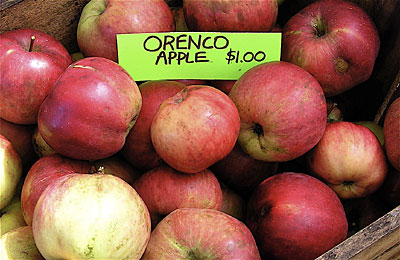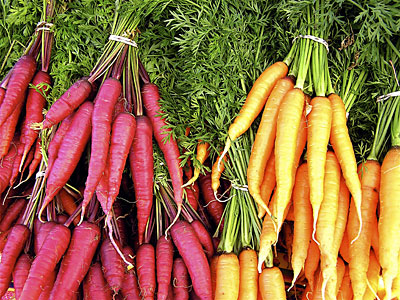 |
| Combine apples and carrots to make delicious muffins this winter. These specimens were seen at the Common Ground Fair – the ‘Orenco’ apples at Mark and Paula Fulford’s Teltane Farm booth. English photos. |
 |
by Cheryl Wixson
Winter sneaks up on us in Maine. The crisp, autumn days get shorter, and cooler. Sunrises are later, sunsets lower and longer. Before we know it, the driving rains of November have washed the leaves from the trees and the last apples have fallen. One morning we awake to see fields and woods softly covered with a fresh snow.
As the weather gradually changes, so do our eating habits. I add white beans to the pasta that is tossed with the last of the sautéed summer tomatoes. The flesh from our Halloween pumpkin is roasted and frozen, ready to be pureed into soups and baked into muffins. Ruby-red cranberries are put up into sauce and relish.
Our salads of leafy greens are now braised spinach and kale or crisp slaws of cabbage and apples. The remains of breakfast’s steaming oatmeal become hot rolls for supper. Burgers on the grill are now meatloaf, stews and beans are simmered on the wood stove, and the house is warmed by potatoes and apples baked in the oven.
In January, this subtle shift in eating is a welcome respite from the over-indulgences of the holidays. Ingredients for my winter menus are economical and simple, and most come from Maine.
My root cellar (and your local farmer or co-op) has carrots, beets, turnip, potatoes, rutabaga, apples, cabbage, celeriac (celery root), onions, shallots and garlic – and, if I’m fortunate, a few winter pears and daikon, or winter radishes. Pantry shelves are lined with the fruits of our summer labor; jars of tomato paste and pizza sauce, pints of bread and butter pickles, spiced peach jam, raspberry jelly, marinated three bean salad, plum chutney, dilly beans and pickled beets. The freezer is stocked with ground beef and lamb, sweet corn scraped from the cob, pesto from summer’s basil, broccoli and cauliflower.
Trips to the root cellar inspire our evening meals. I visit my apples weekly, feeling and sorting, bringing a new supply to the kitchen. Saturday night’s supper of baked beans, chicken sausage and hot and sour slaw is often elevated by a dessert of baked apples. Wolf River are my favorite. I core and perch each one in a pool of butter in ramekins, stuffing the middle with dried cranberries and maple syrup, baking them until the flesh explodes their skin. Topped with rich Jersey cream, there is no finer dessert.
Butternut and Delicata squash stored in the unheated bedroom need frequent inspection also. Cubes of butternut squash are perfect for sautéing with cumin seeds, onions, garlic and leeks. As they start to soften, add coconut milk, red curry paste, whole cloves and cinnamon. Serve over white rice sprinkled with cashews. Delicious!
Delicata squash are great for oven roasting. Cut each one in half and scrape out the seeds. Fill the cavity with olive oil or maple syrup, sprinkle with salt and pepper, roast at 400 degrees until a fork pierces the flesh easily. Enjoy with a cheese and broccoli baked potato. Leftovers squash halves freeze conveniently in Ziploc bags and reheat easily.
We are big believers in this cook-once-eat-twice method of food preparation. Meat remaining from Sunday’s roasted chicken is added to leftover carrots and gravy, spooned into individual casseroles, covered with mashed potato and frozen for next week’s lunch of chicken pot pies. Sliced, cooked beets from dinner are chopped for salads for later. Roasted potatoes go into home fries or hash, braised greens into stews, chicken sausage atop pizza. Extra grated apples and carrots from supper’s slaw make wonderful morning muffins (recipe below).
Winter in Maine also brings fresh shrimp and scallops. Scallop season usually starts in December and runs until the end of March. Scallops are a luxury, but I always buy a few pounds fresh off the boat and freeze them for special occasions. One of our favorite meals is fresh Maine scallops sautéed in butter, hand-cut French-fried potatoes roasted in the oven, and a salad of chopped beets and cabbage tossed with balsamic vinegar and goat cheese, topped with toasted walnuts.
Maine shrimping, traditionally done in January and February, brings an economical source of protein, especially if you shuck the shrimp yourself. These tiny shrimp freeze well for you to enjoy all year. They are delicious sautéed with butter and garlic, or quickly boiled and made into shrimp salad. At the height of the season, I like to make a large batch and freeze quarts of Stonington Seafood Chowder: 2 pounds each of scallops, shrimp and crab simmered with Maine potatoes, onions, organic whole milk and a touch of cream. We often enjoy Corn Pudding with Maine Shrimp (recipe below), accompanied by canned marinated bean salad or greens from the freezer and fresh applesauce.
By the time winter’s deep snows are upon us, we are blissfully enjoying the pleasures of the season. The complex carbohydrates of beans and root vegetables sustain and energize us through the cold winter. The beta-carotene, antioxidants and phytochemicals in squashes, apples and blueberries give our bodies extra defenses to ward off colds and the flu. Most importantly, this period of simplified eating allows us time for reflection, and the opportunity to give thanks for the farmers who provide us with food independence.
Apple Carrot Muffins
These tasty treats are a snap to whip up in your food processor, or use a grater. Apple Carrot Muffins utilize two winter staples and are a good source of fiber, and trace minerals manganese and selenium.
1 1/2 c. grated or chopped raw, unpeeled apples (about 3 medium)
1/2 c. grated carrot (about 1 medium)
1/4 c. butter at room temperature
1 tsp. lemon extract
2 eggs
1 3/4 c. whole wheat or whole meal flour [Whole meal flour is made by grinding grain (wheat berries) and contains the germ and bran of the wheat. Purchased it in health food stores, or substitute whole wheat flour.]
1 tsp. baking powder
1 tsp. baking soda
1/2 c. chopped raisins
1/2 c. chopped walnuts
Preheat the oven to 350 degrees. Grease a loaf pan or a 12-cup muffin tin.
In the bowl of your food processor, chop the apples, carrots, raisins and walnuts. Scrape them into the bowl of your electric mixer. Add the lemon extract, eggs and butter. Mix until combined. Add the baking powder, baking soda and flour and mix well. Spoon the mixture into the loaf pan or muffin tin and bake until it tests done with a toothpick, about 45 to 50 minutes for bread and 15 to 20 minutes for muffins. Let cool in the pan for 10 minutes before removing to a rack to cool. Make 12 servings.
Nutritional analysis per serving:
181 calories, 5 g. protein, 24 g. carbohydrates, 8 g. fat (0 g. transfat), 169 mg. sodium, 4 g. fiber.
Corn Pudding with Maine Shrimp
This delicious custard is thickened by puréeing half the corn in the food processor. Dried basil, Maine shrimp and goat cheese contribute to the flavors. You can make this versatile pudding with other cooked vegetables, dill or parsley, even lobster. Corn Pudding is perfect for using leftover corn-on-the-cob, or use frozen corn; just be sure it is extra-sweet.
2 c. sweet corn (1 12-ounce package of frozen corn)
1 tsp. dried basil
1 1/2 Tbps. all purpose flour
1 c. milk
2 eggs
Sea salt and fresh pepper to taste
2 oz. chevre (Maine goat cheese) (optional)
8 oz. Maine shrimp meat
Grease an 8” x 8” glass baking pan. Preheat the oven to 350 degrees.
In the bowl of your food processor, pulse 1 cup of the sweet corn until chopped. Scrape into a large bowl. Stir in the remaining corn, basil and flour. Whisk in the milk and eggs. Season with sea salt and fresh pepper. Pour the mixture into the baking dish. Sprinkle the goat cheese and shrimp meat over the mixture. Bake in the oven until set, about 30 to 45 minutes. Let stand 15 minutes before serving. Corn Pudding with Maine Shrimp may be served hot, cold or at room temperature. Makes 6 servings.
Nutritional analysis per serving:
161 calories, 15 g. protein, 15 g. carbohydrates, 5 g. fat (0 g. transfat), 133 mg. sodium, 1.5 g. fiber.
